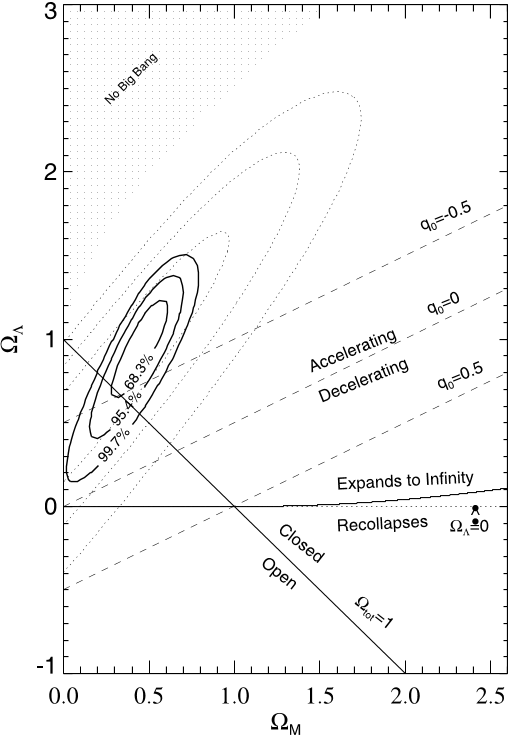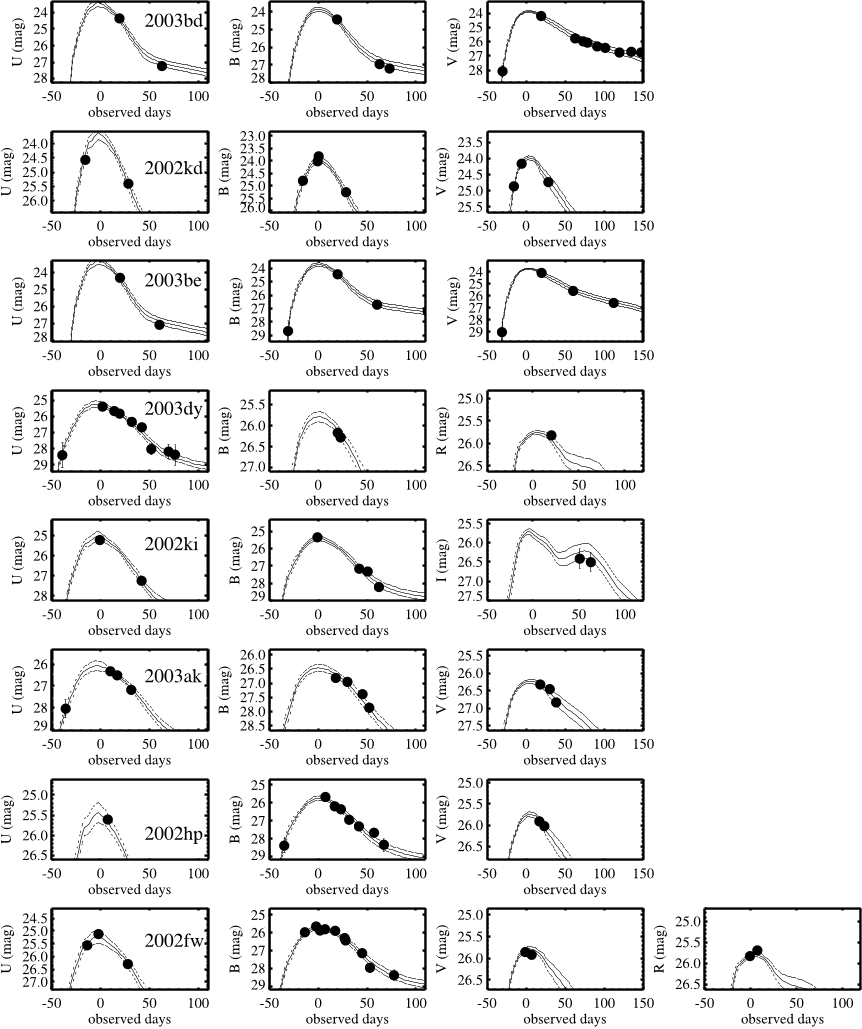Type Ia supernova discoveries at z > 1 from the Hubble Space Telescope: Evidence for past deceleration and constraints on dark energy evolution
Adam G. Riess,Louis-Gregory Strolger,John L. Tonry,Stefano Casertano,Henry C. Ferguson,Bahram Mobasher,Peter Challis,Alexei V. Filippenko,Saurabh Jha,Weidong Li,Ryan Chornock,Robert P. Kirshner,Bruno Leibundgut,Mark Dickinson,Mario Livio,Mauro Giavalisco,Charles C. Steidel,Txitxo Benítez,Zlatan Tsvetanov +18 more
TLDR
For a flat universe with a cosmological constant, the transition between the two epochs is constrained to be at z = 0.46 ± 0.13 as mentioned in this paper, and w = -1.02 ± (and w < -0.76 at the 95% confidence level) for an assumed static equation of state of dark energy.Abstract:
We have discovered 16 Type Ia supernovae (SNe Ia) with the Hubble Space Telescope (HST) and have used them to provide the first conclusive evidence for cosmic deceleration that preceded the current epoch of cosmic acceleration. These objects, discovered during the course of the GOODS ACS Treasury program, include 6 of the 7 highest redshift SNe Ia known, all at z > 1.25, and populate the Hubble diagram in unexplored territory. The luminosity distances to these objects and to 170 previously reported SNe Ia have been determined using empirical relations between light-curve shape and luminosity. A purely kinematic interpretation of the SN Ia sample provides evidence at the greater than 99% confidence level for a transition from deceleration to acceleration or, similarly, strong evidence for a cosmic jerk. Using a simple model of the expansion history, the transition between the two epochs is constrained to be at z = 0.46 ± 0.13. The data are consistent with the cosmic concordance model of ΩM ≈ 0.3, ΩΛ ≈ 0.7 (χ = 1.06) and are inconsistent with a simple model of evolution or dust as an alternative to dark energy. For a flat universe with a cosmological constant, we measure ΩM = 0.29 ± (equivalently, ΩΛ = 0.71). When combined with external flat-universe constraints, including the cosmic microwave background and large-scale structure, we find w = -1.02 ± (and w < -0.76 at the 95% confidence level) for an assumed static equation of state of dark energy, P = wρc2. Joint constraints on both the recent equation of state of dark energy, w0, and its time evolution, dw/dz, are a factor of ~8 more precise than the first estimates and twice as precise as those without the SNe Ia discovered with HST. Our constraints are consistent with the static nature of and value of w expected for a cosmological constant (i.e., w0 = -1.0, dw/dz = 0) and are inconsistent with very rapid evolution of dark energy. We address consequences of evolving dark energy for the fate of the universe.read more
Figures

TABLE 2 SN Ia Imaging 
Fig. 8.—Joint confidence intervals for ( M , ) from SNe Ia. The solid contours are results from the gold sample of 157 SNe Ia presented here. The dotted contours are the results from Riess et al. (1998) illustrating the earlier evidence for > 0. Regions representing specific cosmological scenarios are illustrated. Contours are closed by their intersection with the line M ¼ 0. 
Fig. 16.—Predicted lensing magnifications of SNe Ia and of random positions in the CDF-S and HDF-N. For the SNe Ia discovered in the GOODS fields, the expected magnification was calculated using a multiple-lens plane formalism, with estimates of foreground lens redshifts and masses derived from the GOODS catalog. Expected magnifications were also calculated for 100 randomly selected positions (redshift and angular position). The solid and dotted lines show redshift bin averages and dispersion, respectively. SNe Ia found in the GOODS survey and in other HST searches are indicated. 
Fig. 15.—Comparison of individual distance differences estimated by the MLCS2k2 and BATM methods for the HST and ground-discovered SNe Ia. The zero points of both methods are normalized by using the same set of SNe Ia. 
Fig. 2.—Multicolor light curves of SNe Ia. For each SN Ia, multicolor photometry transferred to rest-frame passbands is plotted. The individual, best-fit MLCS2k2 model is shown as a solid line, with a 1 model uncertainty, derived from the model covariance matrix, above and below the best fit. 
Fig. 17.—Correlation of the predicted magnification and the best-fit cosmological model residual for individual SNe Ia. The predicted magnifications are as described in Fig. 16. The residuals are the difference in distance modulus as predicted from the best-fit model ( M ¼ 0:3, ¼ 0:7) and as observed. The empirical correlation is expected to be unity (if the lens light traces their mass) and is shown for the whole sample and without SN 1997ff, the SN with the largest residual and predicted magnification.
Citations
More filters
Journal ArticleDOI
Black hole entropy in scalar-tensor and f(R) gravity: an overview
TL;DR: In this paper, a short overview of black hole entropy in alternative gravitational theories is presented, motivated by the recent attempts to explain the cosmic acceleration without dark energy, focusing on metric and Palatini f(R) gravity and on scalar-tensor theories.
Journal ArticleDOI
Some exact solutions in f(,T) gravity via Noether symmetries
M. Farasat Shamir,Mushtaq Ahmad +1 more
TL;DR: In this article, the modified Gauss-Bonnet gravity model was investigated for locally rotationally symmetric Bianchi type I universe with anisotropic background and the Noether symmetry equations for modified f(𝒢,T) gravity were derived.
Journal ArticleDOI
Cosmokinetics: A joint analysis of Standard Candles, Rulers and Cosmic Clocks
TL;DR: In this article, the accelerated expansion of the universe was studied by using the kinematic approach, in which the deceleration parameter, q(z), was parameterized in a model independent way.
Journal ArticleDOI
Effects of shear and rotation on the spherical collapse model for clustering dark energy
TL;DR: In this article, the influence of shear and rotation terms for dark matter fluid in clustering dark energy models is studied, for different equations of state, and the effects of these terms on the linear overdensity threshold parameter, and on the virial overdensity, are evaluated.
Journal ArticleDOI
The Hubble Space Telescope Cluster Supernova Survey: III. Correlated Properties of Type Ia Supernovae and Their Hosts at 0.9 < z < 1.46
Joshua Meyers,Greg Aldering,K. Barbary,L. F. Barrientos,M. Brodwin,Kyle S. Dawson,Susana E. Deustua,Mamoru Doi,Peter Eisenhardt,L. Faccioli,H. K. Fakhouri,A. S. Fruchter,David Gilbank,Michael D. Gladders,Gerson Goldhaber,Anthony H. Gonzalez,Takashi Hattori,Eric Hsiao,Yutaka Ihara,Nobunari Kashikawa,Benjamin P. Koester,Kohki Konishi,C. Lidman,Lori M. Lubin,Tomoki Morokuma,Takeshi Oda,Saul Perlmutter,Marc Postman,P. Ripoche,Piero Rosati,David Rubin,Eli S. Rykoff,A. L. Spadafora,S. A. Stanford,Nao Suzuki,Naohiro Takanashi,Kouichi Tokita,Naoki Yasuda +37 more
TL;DR: In this paper, the authors used galaxy color and quantitative morphology to determine the red sequence in 25 clusters and developed a model to distinguish passively evolving early-type galaxies from star-forming galaxies in both clusters and the field.
References
More filters
Journal ArticleDOI
Measurements of Omega and Lambda from 42 High-Redshift Supernovae
Saul Perlmutter,Saul Perlmutter,Greg Aldering,Gerson Goldhaber,Gerson Goldhaber,R. A. Knop,Peter Nugent,P. G. Castro,P. G. Castro,Susana E. Deustua,Sebastien Fabbro,Sebastien Fabbro,A. Goobar,A. Goobar,Donald E. Groom,I. M. Hook,I. M. Hook,A. G. Kim,A. G. Kim,A. G. Kim,M. Y. Kim,Julia C. Lee,Julia C. Lee,Nelson J. Nunes,Nelson J. Nunes,Reynald Pain,Reynald Pain,C. R. Pennypacker,C. R. Pennypacker,Robert Quimby,Christopher Lidman,Richard S. Ellis,Mike Irwin,Richard G. McMahon,Pilar Ruiz-Lapuente,Nicholas A. Walton,Bradley E. Schaefer,B. J. Boyle,Alexei V. Filippenko,Thomas Matheson,A. S. Fruchter,Nino Panagia,Nino Panagia,Heidi Jo Newberg,Warrick J. Couch +44 more
TL;DR: In this paper, the mass density, Omega_M, and cosmological-constant energy density of the universe were measured using the analysis of 42 Type Ia supernovae discovered by the Supernova Cosmology project.
Journal ArticleDOI
Observational Evidence from Supernovae for an Accelerating Universe and a Cosmological Constant
Adam G. Riess,Alexei V. Filippenko,Peter Challis,Alejandro Clocchiatti,Alan H. Diercks,Peter M. Garnavich,R. L. Gilliland,Craig J. Hogan,Saurabh Jha,Robert P. Kirshner,Bruno Leibundgut,Mark M. Phillips,David J Reiss,Brian P. Schmidt,R. A. Schommer,R. Chris Smith,R. Chris Smith,Jason Spyromilio,Christopher W. Stubbs,Nicholas B. Suntzeff,John L. Tonry +20 more
TL;DR: In this article, the authors used spectral and photometric observations of 10 Type Ia supernovae (SNe Ia) in the redshift range 0.16 " z " 0.62.
Journal ArticleDOI
Maps of Dust Infrared Emission for Use in Estimation of Reddening and Cosmic Microwave Background Radiation Foregrounds
TL;DR: In this article, a reprocessed composite of the COBE/DIRBE and IRAS/ISSA maps, with the zodiacal foreground and confirmed point sources removed, is presented.
Journal ArticleDOI
Maps of Dust IR Emission for Use in Estimation of Reddening and CMBR Foregrounds
TL;DR: In this paper, the authors presented a reprocessed composite of the COBE/DIRBE and IRAS/ISSA maps, with the zodiacal foreground and confirmed point sources removed.
Journal ArticleDOI
Observational Evidence from Supernovae for an Accelerating Universe and a Cosmological Constant
Adam G. Riess,Alexei V. Filippenko,Peter Challis,Alejandro Clocchiattia,Alan H. Diercks,Peter M. Garnavich,R. L. Gilliland,Craig J. Hogan,Saurabh Jha,Robert P. Kirshner,Bruno Leibundgut,Mark M. Phillips,David J Reiss,Brian P. Schmidt,Robert A. Schommer,R. Chris Smith,Jason Spyromilio,Christopher W. Stubbs,Nicholas B. Suntzeff,John L. Tonry +19 more
TL;DR: In this paper, the authors present observations of 10 type Ia supernovae (SNe Ia) between 0.16 0 and 4.0 sigma confidence levels, for two fitting methods respectively.
Related Papers (5)
Measurements of Omega and Lambda from 42 High-Redshift Supernovae
Saul Perlmutter,Saul Perlmutter,Greg Aldering,Gerson Goldhaber,Gerson Goldhaber,R. A. Knop,Peter Nugent,P. G. Castro,P. G. Castro,Susana E. Deustua,Sebastien Fabbro,Sebastien Fabbro,A. Goobar,A. Goobar,Donald E. Groom,I. M. Hook,I. M. Hook,A. G. Kim,A. G. Kim,A. G. Kim,M. Y. Kim,Julia C. Lee,Julia C. Lee,Nelson J. Nunes,Nelson J. Nunes,Reynald Pain,Reynald Pain,C. R. Pennypacker,C. R. Pennypacker,Robert Quimby,Christopher Lidman,Richard S. Ellis,Mike Irwin,Richard G. McMahon,Pilar Ruiz-Lapuente,Nicholas A. Walton,Bradley E. Schaefer,B. J. Boyle,Alexei V. Filippenko,Thomas Matheson,A. S. Fruchter,Nino Panagia,Nino Panagia,Heidi Jo Newberg,Warrick J. Couch +44 more
Observational Evidence from Supernovae for an Accelerating Universe and a Cosmological Constant
Adam G. Riess,Alexei V. Filippenko,Peter Challis,Alejandro Clocchiatti,Alan H. Diercks,Peter M. Garnavich,R. L. Gilliland,Craig J. Hogan,Saurabh Jha,Robert P. Kirshner,Bruno Leibundgut,Mark M. Phillips,David J Reiss,Brian P. Schmidt,R. A. Schommer,R. Chris Smith,R. Chris Smith,Jason Spyromilio,Christopher W. Stubbs,Nicholas B. Suntzeff,John L. Tonry +20 more
First year Wilkinson Microwave Anisotropy Probe (WMAP) observations: Determination of cosmological parameters
David N. Spergel,Licia Verde,Hiranya V. Peiris,Eiichiro Komatsu,M. R. Nolta,Charles L. Bennett,Mark Halpern,Gary Hinshaw,N. Jarosik,Alan J. Kogut,Michele Limon,Michele Limon,S. S. Meyer,Lyman A. Page,Gregory S. Tucker,Gregory S. Tucker,Gregory S. Tucker,Janet L. Weiland,Edward J. Wollack,Edward L. Wright +19 more
Detection of the baryon acoustic peak in the large-scale correlation function of SDSS luminous red galaxies
Daniel J. Eisenstein,Daniel J. Eisenstein,Idit Zehavi,David W. Hogg,Roman Scoccimarro,Michael R. Blanton,Robert C. Nichol,Ryan Scranton,Hee-Jong Seo,Max Tegmark,Max Tegmark,Zheng Zheng,Scott F. Anderson,James Annis,Neta A. Bahcall,Jon Brinkmann,Scott Burles,Francisco J. Castander,Andrew J. Connolly,István Csabai,Mamoru Doi,Masataka Fukugita,Joshua A. Frieman,Joshua A. Frieman,Karl Glazebrook,James E. Gunn,John S. Hendry,Greg Hennessy,Zeljko Ivezic,Stephen M. Kent,Gillian R. Knapp,Huan Lin,Yeong Shang Loh,Robert H. Lupton,Bruce Margon,Timothy A. McKay,Avery Meiksin,Jeffrey A. Munn,Adrian Pope,Michael W. Richmond,David J. Schlegel,Donald P. Schneider,Kazuhiro Shimasaku,Chris Stoughton,Michael A. Strauss,Mark SubbaRao,Mark SubbaRao,Alexander S. Szalay,István Szapudi,Douglas L. Tucker,Brian Yanny,Donald G. York +51 more